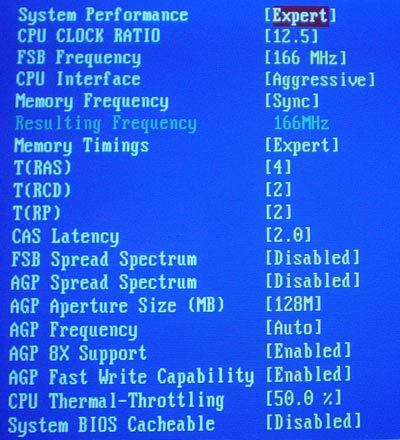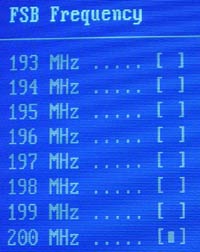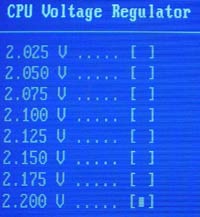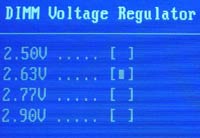nForce2 6-way Motherboard Roundup - December 2002
by Evan Lieb on December 4, 2002 6:53 PM EST- Posted in
- Motherboards
Epox 8RDA+: BIOS and Overclocking
Epox decided to choose Phoenix Technology's Award BIOS for their first nForce2 motherboard. This isn't unusual, especially since all nForce2 motherboards use Award BIOSes.

The PC Health section of the 8RDA+ BIOS includes an average amount of readings. These include system and CPU temperature, fan speeds (chassis, power, and CPU), VAGP, Vcore, VDIMM, PSU readings (all rails), and a battery voltage reading. There are also two other options in this section for adjusting CPU Warning Temperature as well as CPU Shutdown Temperature.

The Advanced Chipset Features section includes the standard amount of options for an nForce2 board, but is quite unconventional compared to the Socket A BIOSes from VIA and SiS motherboards, as all nForce2 BIOSes are. In the 8RDA+ Advanced Chipset Features section, there are adjustments for the CPU multiplier, CPU interface, memory frequency, various memory timings (including Active to Precharge, Precharge to Active, Active to CMD, and CAS latency). Precharge to Active and Active to CMD timings are adjustable from 1-7T and Active to Precharge is adjustable between 1T and 15T. These are definitely the most flexible timings we've ever seen, though only the Active to Precharge timing is able to take advantage of this fact.

The FSB ceiling in the BIOS was surprisingly low, especially for an Epox motherboard. The max available option is 200MHz, which certainly isn't bad, but we would have liked to have seen something higher, as upcoming 200MHz FSB (400MHz effective) Athlon XP Barton processors won't be able to overclock at all using this particular 8RDA+ BIOS. Somehow we doubt Epox will leave out the option for raising the FSB past 200MHz in a future BIOS. 12/04/02 UPDATE: Apparently, there is a very recent 8RDA+ BIOS out that allows up to 211MHz FSB adjustement.
Voltage tweaking potential in the 8RDA+ BIOS is quite good. Vcore is adjustable up to 2.20V in .025V increments. This should be more than enough for even the most extreme overclockers, and that includes HSF and water cooling overclockers. This is especially true of Thoroughbred-B users due to the fact that 2400+ processors and up have a stock Vcore of 1.65V, meaning you can adjust Vcore by a full 0.55V if need be, which is tremendous. Of course, Vcore fluctuates between 1.65 and 1.66V at idle according to the PC Health readings in the BIOS, so you actually have the potential for 2.20V, though we very strongly advise against operating your CPU at this high of a Vcore.
 |
 |
Epox has been known to include some impressive VDIMM potential in their performance BIOSes, and this holds true for the most part with the 8RDA+. In 0.13V and 0.14V increments, you're allowed to adjust VDIMM up to 2.9V. VDIMM fluctuates between 2.62 and 2.63V per PC Health, so you can reach an actual 2.9VDIMM. Again, this high of a voltage isn't advisable, as operating your memory at anything over 2.7-2.8V usually isn't a very good idea if you plan on using your RAM for more than a couple months.
As far as we can tell, the Epox 8RDA+ contains just an AGP lock, but no visible PCI lock. We've haven't been able to get confirmation from Epox as to whether this board locks the PCI bus at 33MHz or not, but we'll update this section as soon as we hear back from Epox.
We had absolutely no trouble overclocking the Epox 8RDA+, and in fact, this board ended up achieving the highest stable FSB out of any other nForce2 motherboard tested in our labs. Here were our FSB overclocking results using the following setup:
|
Front Side Bus Overclocking Testbed |
|
|
Processor:
|
Athlon
XP 2400+
|
|
CPU
Vcore:
|
1.65V
|
|
Cooling:
|
AMD
Retail HSF & Thermal Pad
|
|
Power
Supply:
|
Enermax
300W
|
It really isn't in the least surprising that the 8RDA+ was the best overclocker out of our six nForce2 motherboards, as Epox has made much of their reputation on highly overclockable (and reasonably priced) motherboards. So, with the above configuration we were able to hit 194MHz FSB (multiplier set to 8X). On that note, it's worth mentioning that the 8RDA+ is yet another nForce2 motherboard that is able to adjust the Thoroughbred-B's multiplier without having to perform any physical modification to the CPU bridges as was the case with previous generation Athlon XP processors (namely the Thunderbird and Palomino processors).
The 8RDA+ BIOS also comes with a ton of multiplier options ranging from 3X to 24X. These multiplier options should satisfy all users.










1 Comments
View All Comments
c627627 - Monday, July 21, 2003 - link
MSI contradicts your reviewhttp://www.anandtech.com/mb/showdoc.html?i=1759&am...
You say:
"12/04/02 UPDATE: MSI sends word that the K7N2-L indeed does not have a PCI bus lock at 33MHz."
To this day, that was used as ultimate proof that the original MSI nForce2 mobo does not have a PCI lock.
Today MSI Senior Moderators said:
"they are wrong,and who ever told them it did not from msi"
(!)
Source:
http://www.msi.com.tw/program/e_service/forum/thre...
Won't you please settle this for us.